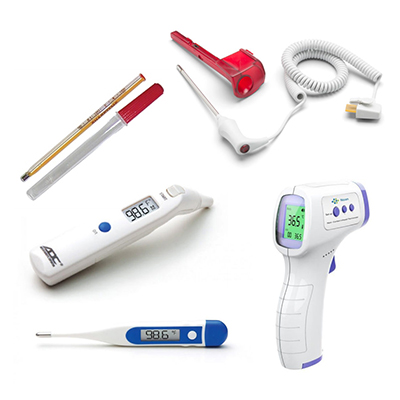Accurate temperature measurement relies on accurate tools. So, when healthcare providers need the best thermometer, what device do they use? There’s no simple answer, and frequently the thermometer that gives the most accurate results depends on the situation and age group of the patient. Thermometers are grouped into two broad categories: how they operate and where on the body they are used.
Thermometers by Method of Operation
Mercury Thermometers
In decades past, mercury thermometers were the only tool available for doctors and parents to get temperature readings. Mercury is contained in a thin glass tube and expands as it warms, filling a scale that indicates temperature. They can be used orally, rectally, or in the armpit/underarm, known as an axillary reading.
In recent decades, technology improved and digital thermometers are more common. In addition, many states have restricted or banned the sale of mercury thermometers for environmental reasons.
Digital Thermometers
Digital thermometers use the same method as mercury thermometers, but use electronic heat sensing technology instead of mercury to provide the temperature reading. They range from inexpensive models to complex smart thermometers with backlit screens and Bluetooth capability.
A drawback of digital thermometers is the battery. Always keep extra on hand and know how to change them, so you’re not stuck with a non-functioning thermometer when you need it most.
Infrared Thermometers
This type of thermometer uses infrared light to measure the temperature of its surroundings and can measure the temperature of a group of people, animals, or food. They can also measure the temperature of liquids.
Infrared thermometers don’t require physical contact with the subject. They are frequently marketed as “no-contact” or “no-touch.” Non-contact infrared thermometers were already seeing widespread use before the start of the recent COVID-19 pandemic.
Thermometers by Body Location
Rectal Thermometers
Rectal thermometers are best for newborns and infants. As the name indicates, they are inserted into the rectum. Rectal thermometers are not recommended for use on older children and adults. It’s important to note that some other types of thermometers only measure surface temperature (your skin) and do not give an accurate reading of how hot or cold your entire body is at any given time. Rectal temperature is a better indicator of the body’s temperature.
The American Academy of Pediatrics also notes that rectal thermometers provide more stable readings than oral or ear-based devices, making them ideal for newborns, as they are too young to communicate their discomfort.
Oral Thermometers
Oral mercury thermometers are what many still think of when they hear the word “thermometer.” However, digital oral thermometers have replaced mercury thermometers nowadays.
Many prefer digital readings from these devices because of their speed and ease of use. The average oral temperature is 98.6 degrees Fahrenheit, the same as normal body temperature. However, this reading can be influenced by other factors. Eating hot or cold food before having their temperature taken or not keeping their mouth closed during reading will affect the result. Plus, certain people also have slightly warmer or cooler mouths.
Tympanic Thermometers
Tympanic thermometers (also known as ear thermometers) use infrared rays to measure temperature in the ear canal. Tympanic thermometers are very fast, so you won’t have to wait for a mercury reading or the beep on other thermometers.
Since they are more comfortable than oral or rectal thermometers and come equipped with a flexible tip, taking a child’s temperature can be much easier with a tympanic thermometer. Earwax in the ear canal can prevent an accurate reading, however. Also, note that tympanic thermometer readings can be anywhere from .5 to 1 degree Fahrenheit higher than measurements from an oral thermometer.
Forehead Thermometers
A forehead thermometer takes the forehead temperature from the temporal artery. The temporal artery is in the temple area of your head, just above and behind the eye. This thermometer uses infrared technology to take an accurate temperature reading by measuring the amount of infrared energy emitted from the skin’s surface.
Temporal artery thermometers are very fast, giving users a reading within a few seconds. Since they take the temperature on the skin’s surface, readings are about 1 degree Fahrenheit cooler than the oral temperature.
Thermometers: The First Line of Defense
Wellness starts with the basics, and sometimes the first indicator that something is wrong is the presence of an elevated temperature. It’s important to know what type of thermometer you need for the right situation. Oral thermometers are perfect for the home, as they provide a very accurate reading in a non-medical setting. Hospital workers and caregivers likely need more options for the different situations they encounter. For a range of thermometers for every use, visit Penn Care: the best source for medical supplies.



